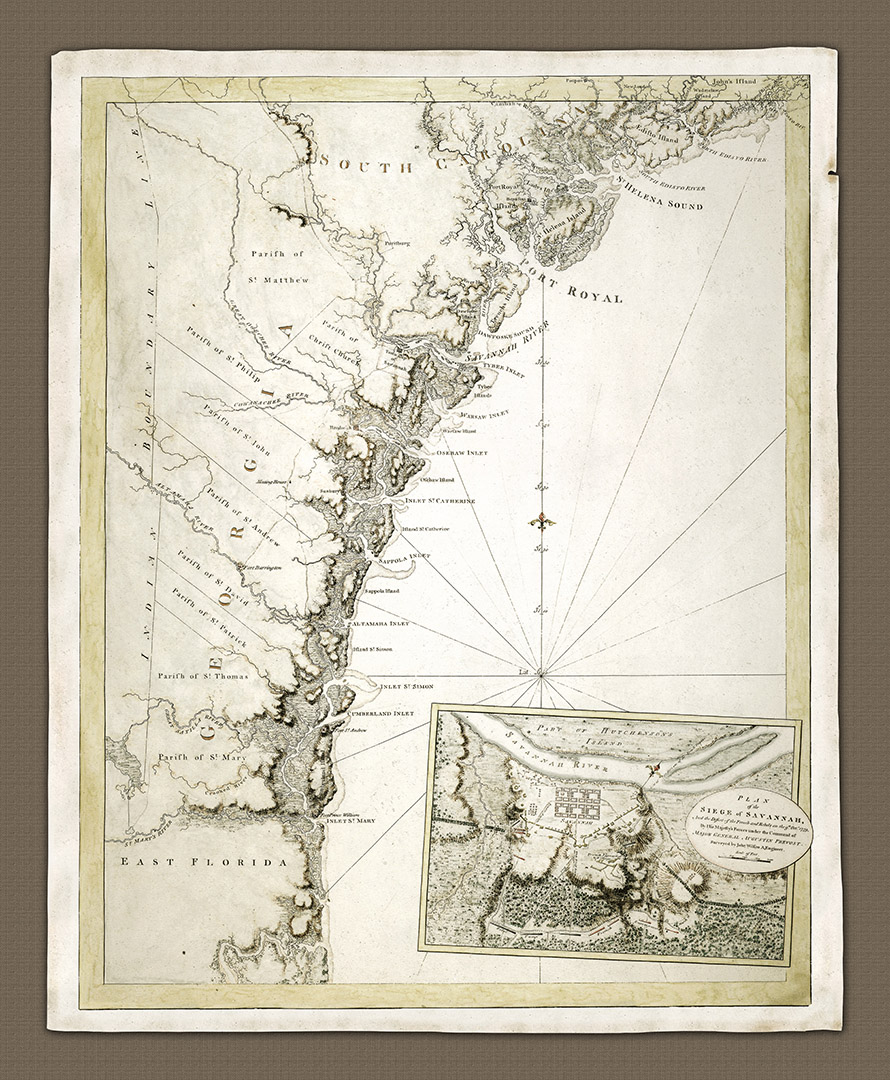A416 - A Plan of the Siege of Savanah
This beautiful plan shows the southern coast of South Carolina and Georgia. It includes an inset depicting the 'defeat of the French and the Rebels on the 9th October 1779 by his Majesty's Forces under the Command of Major General Augustin Prevost' with the survey of defences as surveyed by British engineer John Wilson.
- 1779
- J.F.W. Des Barres
- h34.5" x w28.5"
- P
The plan was produced by J.F.W. Des Barres for inclusion in the Atlantic Neptune folio as part of the new 'political mapping' direction he was forced to follow after the outbreak of the war of Independence whereby pure topographic information was not enough to capture the interest of the public back in England.
Georgia was significantly different from other colonies in that it did not have the political infrastructure that had developed over the last century in Virginia, for example. Georgia had the smallest population of the 13 colonies and did not require the overhead of local governments. Parishes were formed between 1757 and 1765 but these were not administrative bodies, much as today's counties are - they were more a part of the religious and military organization.
It is worth noting that the main part of the map shows the boundaries between the Parishes, and it also depicts in detail the coastal features including inlets, rivers, marsh land, sand banks and the borders of the Indian territories which were significant at the time. The plan also marks and names forts and settlements up and down the coast.
By the time this plan was compiled the British had already decided that by occupying key towns such as Savannah in Georgia and Charleston in South Carolina, and by mobilizing and arming the loyalist population, including the slaves, they hoped to achieve the following:
1. Split the 'middle' states from the other more northerly states and retain them as part of the British Empire.
2. The more loyalists that could be assimilated into the army, the more British troops could be concentrated elsewhere.
3. They might yet retain financial control - apart from anything else these 'middle' states produced the commodities upon which the economics of Empire was built - tobacco, rice, indigo and so on.
4. They may yet link these states along with their holdings in east Florida, the Bahamas and Bermuda as a new colonial grouping to compensate for the loss of the New England states. Having taken Savannah on December 29th 1778 with 2,500 troops under Lt. Col. Archibald Campbell as the opening operation in their new 'Southern Strategy', the British set about taking control of Georgia with the help of locally enlisted Loyalist support.
The importance of a town such as Savannah was such that it became a priority for the Americans to retake the coastal Georgia port. The recent emergence of the French as an ally was central to this operation.
Admiral Valerie D'estaing, still unhappy at his recent failure in Rhode Island against the British, was sent to provide naval support in a combined blockade and attack, alongside the Americans. On his arrival he, crucially, delayed launching an attack on the under-prepared British who were holding the town of Savannah. By the time the Americans, under the command of Major General Benjamin Lincoln, had positioned their troops and agreed the plan with the French commanders, it was the 23rd September, and the British had finished reinforcing the town defences and had called for support from Loyalists in South Carolina. By the 4th October it was clear that the British were not going to surrender and the American and French allies began their attack across a broad front on the 9th October. They were repulsed and Savannah remained under British control until July 1782.
- A Plan of the Siege of Savanah


